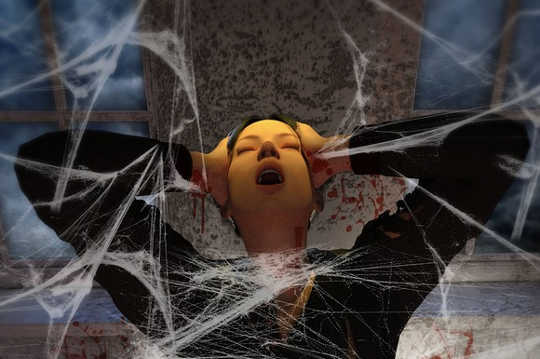
Unexpressed anger is behind our negativity. It's easy to give in to the impulse to only look at what is lacking. Then we justify our hurtful words and destructive actions with our unspoken thoughts. Examples of these thoughts include: "You're wrong, I'm right." Or "This will never work out." Or "I blew it again." As a consequence, we become the stick in the mud and view ourselves, other people, and situations in less than favorable ways. We then always have something negative to say, regardless of the topic. Long gone are our feelings of love, compassion, and optimism.
When we don't express our anger constructively, we go negative with our judgments and feel mad because the world isn't living up to our expectations. Over the years, this becomes the lens through which we view the world. Instead of dealing with our emotions, like a child who spontaneously throws a tantrum and then moves back to being present, we go mental, get righteous, and think that other people or things "should" be the way we think they should be. We become stuck in our myopic way of negatively interpreting events.
Maybe we resort to being sarcastic, critical, or demeaning, especially if that is what was modeled by our caretakers. Our unrealistic expectations about people and things keep us feeling angry, disappointed, and pessimistic. When others aren't being the way we think they should be, our negative way of speaking and acting fuels more anger in ourselves and those around us.
This approach creates feelings of separation and magnifies differences, thereby diminishing the amount of love we feel. So rather than continuing to act based on our unexpressed anger and being a "Debbie Downer," there is something simple we can do.
Anger is an Emotion, a Physiology in the Body
Anger in itself is not a bad thing. It is the natural emotional and physical response when we perceive injustices and violations, just as it's natural to cry when we experience hurts and losses. But instead of dealing with the anger, we tend to go negative.
Anger is energy in our bodies; just as wind is energy. Symptoms include the body temperature rising, muscle tension, teeth grinding, fist clenching, flushing, prickly sensations, and sweating.
It's time to set aside your pride and do something different. I know it's hard but each time you check the impulse to lash out negatively physically, mentally, verbally, or emotionally, and make a choice to take a higher road, you will notice the difference.
Express Your Anger Energy, Physically and Constructively
Take note when you're feeling that energy in your body - hot and aggressive - and deal with the anger constructively. Follow the lead of a toddler and have that tantrum rather than pulling away, blasting it on others, or destroying things of value, such as others' tender hearts.
I suggest that in order to deal with our emotional anger energy in a healthy way, do the following:
- Find a safe place where you can release your pent up anger physically and naturally in a non-damaging way. This could be your garage, bathroom, bedroom, or car (not when you're driving, of course).
- Express the anger energy hard, fast, and with abandon. You can punch a heavy bag or mattress, use a flexible plastic hose on some old telephone books, or grip the steering wheel and shake it. You can push against a door jamb or fireplace mantle. Another easy way to do this is to lie on your back on a bed and flail your arms, legs, and head while yelling and growling. Or you can pound clay or kneed dough. Throw rocks. Yank out weeds with abandon. Stomp around. Push against a wall or doorjamb. Shout into a pillow.
- Persist and move the energy out of your body. Do it until you're exhausted. Catch your breath and do it again. Repeat until you can't anymore!
- Make sounds and noises because emotions are beyond the realm of words. No blaming or swearing. If you use words, yell something like, "I feel so angry. I feel so mad. I feel so pissed!" Saying negative things directed at others while expressing anger physically, just stokes the fire and reinforces thinking that the outside world is the problem.
You'll only feel embarrassed until the satisfaction and benefits become obvious. Here's a video that shows Christy constructively moving the anger energy out of her body. She felt great when she was finished!
{vembed Y=nQcpGLJYE7s}
Rewire Your Negative Thinking
After you have physically released your anger (or if you want to skip the above step), you need to accept the reality -- what is, is. This is the key to getting rid of negativity.
The best way to do this is to tell yourself, over and over, that: "People and things are the way they are, not the way I want them to be," "This is the way it is," or "That's the way they are."
When these phrases (Truths) are repeated constantly and with focus and enthusiasm, your anger becomes amused acceptance. The truth of these words eventually sinks in and becomes reality. It's your ticket out of your old anger pattern. Keep at it until you truly accept the person or situation, just the way you accept the color of their eyes or that the world is round.
Acceptance does not mean passivity. First you must truly accept what is. Let go of your fantasy of how it should be, even though in your perfect world it would be different.
Another way to attack your negative thinking is to interrupt all those negative thoughts and words, and vigilantly replace them with something positive. This means looking for the good, no matter the situation. There is always some silver lining even in the most dire of circumstances.
This strategy takes persistence but it can become a fun game, as you slap an appreciation or "gratitude" on virtually every moment. At some point you will win the battle with the negativity and looking at the sunny side will prevail.
Look Within to Determine what Action to Take and Take It
After you have released your anger and accepted the reality of the situation or person, it's time to pause and look within your heart to decide what you need to say and/or do. Ask yourself, "What would be the highest / most loving thing to do?" "What will bring me more joy, love, and peace?" Listen to your heart and find what really resonates for you.
If you know you need to speak up about something in order to feel like you can let an upset go and return to positivity, be sure you talk about what's true for you. This means your communication is not laced with finger-pointing, blaming, or doom and gloom. Stick with addressing one specific situation at a time, saying what you need, want, or believe in a kind way. As well, you need to listen to understand other people's views and work together to find solutions that honor everyone concerned.
I suggest you write what you want to say out and rehearse it. Do it in front of a mirror or with a friend. This is a huge behavior change and it's bound to feel awkward at first so I can't stress enough the importance of preparation and practice so that your words and actions are clear, loving, and bring the most favorable outcome.
The Rewards
Our thoughts and emotions are powerful and can be used to uplift us or bring us down. If we dwell on the negative, it's as if we are walking around with a loaded gun that we can use to inflict harm, over and over.
If we act from a place of true acceptance and positivity, we are able to generate kindness and love. Genuinely give to others, both in words and deeds. It feels good, and has a positive effect on others and the world.
©2019 by Jude Bijou, M.A., M.F.T.
All Rights Reserved.
Book by this Author
Attitude Reconstruction: A Blueprint for Building a Better Life
by Jude Bijou, M.A., M.F.T.
 With practical tools, real-life examples, and everyday solutions for thirty-three destructive attitudes, Attitude Reconstruction can help you stop settling for sadness, anger, and fear, and infuse your life with love, peace, and joy.
With practical tools, real-life examples, and everyday solutions for thirty-three destructive attitudes, Attitude Reconstruction can help you stop settling for sadness, anger, and fear, and infuse your life with love, peace, and joy.![]()
About the Author
 Jude Bijou is a licensed marriage and family therapist (MFT), an educator in Santa Barbara, California and the author of Attitude Reconstruction: A Blueprint for Building a Better Life. In 1982, Jude launched a private psychotherapy practice and started working with individuals, couples, and groups. She also began teaching communication courses through Santa Barbara City College Adult Education. Visit her website at AttitudeReconstruction.com/
Jude Bijou is a licensed marriage and family therapist (MFT), an educator in Santa Barbara, California and the author of Attitude Reconstruction: A Blueprint for Building a Better Life. In 1982, Jude launched a private psychotherapy practice and started working with individuals, couples, and groups. She also began teaching communication courses through Santa Barbara City College Adult Education. Visit her website at AttitudeReconstruction.com/
* Watch an interview with Jude Bijou: How to Experience More Joy, Love and Peace
Related Video
{vembed Y=i44Ni3jxt38}
Related Books
at InnerSelf Market and Amazon




























